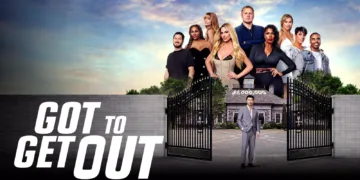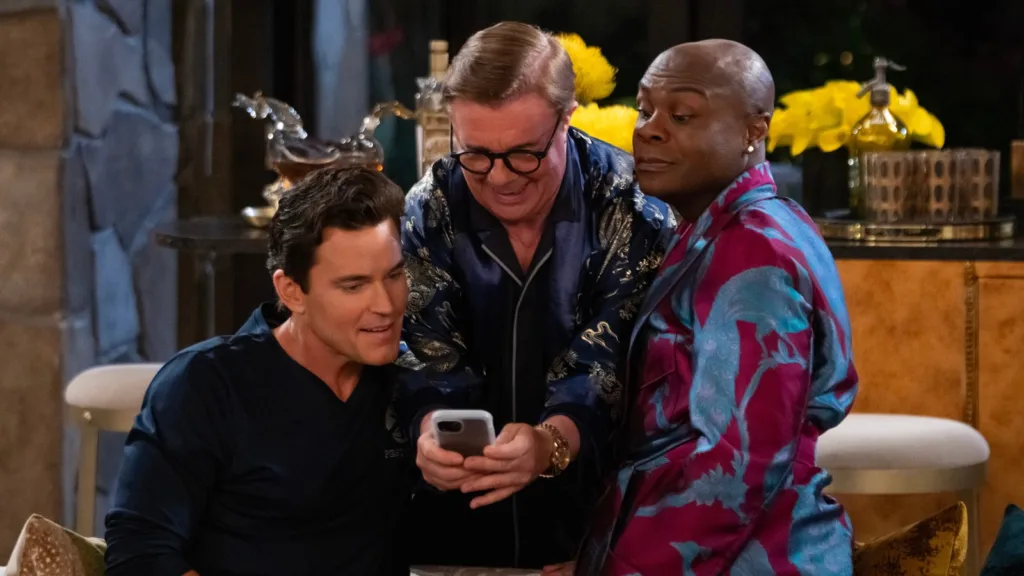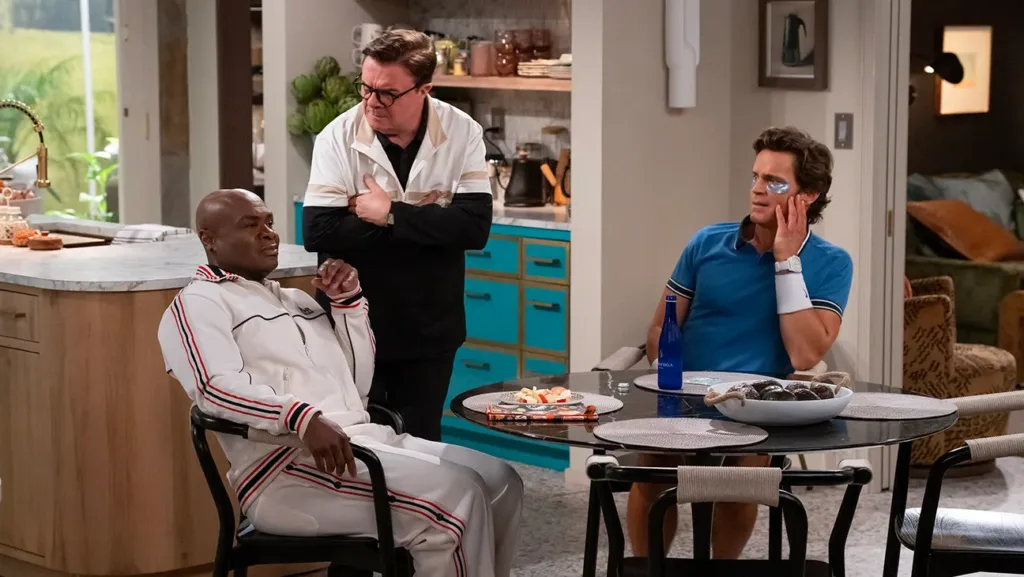Mid-Century Modern presents a stage where laughter and loss coexist in a curious mixture. Set in Palm Springs, this multi-camera, live-audience sitcom follows a group of longtime gay friends whose reunion is sparked by an unforeseen farewell. The initial funeral scene—witnessed in silence and unexpected humor—provokes reflections on mortality and the weight of shared history (a moment reminiscent of scenes in classic films that challenge viewers to smile amid sorrow).
Bunny Schneiderman, a prosperous figure in the brassiere market, extends an invitation to his close companions Arthur and Jerry, forming a living arrangement that defies ordinary family constructs. Alongside them, Bunny’s mother, Sybil, offers both affectionate care and mischievous intervention. This setup creates a microcosm of domesticity that is both charming and disarmingly unconventional.
The creators invoke the nostalgic spirit of traditional sitcoms, crafting a visual and thematic style that calls to mind eras past while engaging with current social conversations. The title itself, “Mid-Century Modern,” serves as a signifier of an aesthetic that honors retro influences and contemporary sensibilities.
The series stands as a cultural artifact, provoking thought about loss, remembrance, and the ways communities reform themselves in times of change. A curious tapestry unfolds—a situation where grief meets quirky humor, evoking reflections on historical shifts in social acceptance.
Characters in Focus: Eccentric Spirits and Domestic Dramas
Bunny Schneiderman stands at the forefront—a man whose prowess in the brassiere industry mirrors his flamboyant personality. His success, palpable as a force of nature, is countered by a latent yearning for a transformative romantic encounter (one might say he oscillates between self-assuredness and moments of surprising insecurity). Bunny acts as the glue for this unconventional household, uniting his friends with a charisma that sometimes falters under the weight of internal conflict.
Arthur Broussard presents a study in contradictions. Once a fashion director revered for his cultural finesse, he now wrestles with the sting of a diminished public persona. His past, colored by elite circles and refined tastes, clashes with his present challenges, revealing a figure whose sophistication is tempered by an unmistakable vulnerability. At times, his penchant for control hints at unresolved self-doubt—a trait that renders him both admirable and, occasionally, exasperating.
Jerry Frank provides a refreshing counterpoint. A former closeted adherent to strict religious mores and now a cheerful flight attendant, he carries the mark of his past with a disarming innocence. His manner, at once simple and earnest, infuses the group with a dose of lighthearted humor (imagine the gentle irony of a man seeking self-acceptance amid a cast of seasoned eccentrics). His growth over the series reflects a quiet evolution, one that challenges the notion of naivety as mere simplicity.
Then there is Sybil Schneiderman, Bunny’s mother—a matriarch with a razor-sharp wit. Her unfiltered commentary and subtle interventions both guide and test Bunny, leaving an indelible impression on the family dynamic.
Recurring guest figures and supporting roles further enrich this ensemble, contributing additional nuances to the interpersonal fabric. The palpable chemistry among the cast suggests that every quip and pause carries a weight that might, in time, influence cultural conversations about chosen family and authenticity.
Emotional Alchemy: Mourning, Maturity, and the Mosaic of Identity
An unexpected loss triggers a cascade of feelings that challenge the characters to confront the impermanence of life (a stark reminder of moments in classic cinema where grief is both a burden and a release). The death at the series’ outset shatters a once-stable equilibrium, compelling the group to forge a new kind of union that is as much about survival as it is about finding solace. This sudden rupture in their world serves as a mirror to historical turning points, where loss redefines society’s course, albeit on a personal scale.
The narrative oscillates between the somber reflection of mortality and the buoyant pulse of human connection. The chosen household becomes a living laboratory for transformation—a space where shared history softens the jagged edges of regret and isolation. In this setting, grief morphs into a curious catalyst for reinventing identity, a process I might term “emotional alchemy” (where sorrow transmutes into a renewed drive for self-realization).
A subtle discourse on aging emerges, casting the characters as modern reflections of timeless archetypes. Their candid musings about the passage of time evoke memories of bygone eras marked by both resilience and regret. This interplay of vulnerability and wisdom brings forth a dynamic tension that is as intellectually stimulating as it is emotionally charged.
The series also examines social constructs through the lens of gay culture. Familiar stereotypes are revisited with a wink and a nod, challenging simplistic portrayals while embracing a spectrum of lived experiences. Here, humor intersects with serious reflection (think of it as a dry, wry commentary on societal norms) to expose the fissures and reinventions in modern identity.
Personal histories, often hinted at in quiet, reflective moments, unravel the complexities behind each character’s public mask. The narrative, rich in symbolic gestures and quietly subversive imagery, pushes viewers to reconsider how personal loss can reshape the cultural fabric of a community.
Crafting Laughter: Wit, Banter, and Physical Comedy
Mid-Century Modern pays homage to a time when television comedy relied on a live, immediate connection with its audience. Its structure and style call to mind the classic multi-camera shows of old, where rapid one-liners and well-timed situational humor were the currency of laughs. The scripted jokes often come in quick succession (think of a verbal ping-pong match that echoes days when a quip was a quip, and no elaborate production was needed to secure a giggle).
At the same time, the show makes an effort to update its humorous language for today’s viewer. Some punchlines may seem rooted in a style of humor that an older generation might recall fondly, yet there is an unmistakable attempt to incorporate modern references that resonate with a 2025 audience. The tension between nostalgia and current trends creates moments that are both endearingly out-of-step and refreshingly relevant.
Dialogue serves as a key element in establishing character, as each line carries the weight of personality. Bunny’s flamboyant retorts, Arthur’s meticulously crafted barbs, and Jerry’s disarmingly sincere remarks infuse the script with a unique vocal fingerprint.
The repartee is often sharp enough to cut through heavier topics, even as it sustains a playful tone. (Occasionally, the dialogue turns into a form of intellectual shorthand—what I might call “quiponomics”—where each word is meticulously measured for its impact.)
Physical comedy is not an afterthought; it appears through choreographed gestures and unexpected stage movements that harken back to theatrical traditions. Visual gags, set pieces, and the deliberate staging of scenes in familiar locales add an extra dimension, offering a counterpoint to the verbal wit. A well-orchestrated dance or a carefully placed prop can provide a moment of relief amidst more serious exchanges, cementing the show’s dual commitment to both humor and heart.
Production Elements and Directorial Vision: A Retrospective Performance
The series benefits from the guidance of James Burrows, whose storied career in television has left an unmistakable imprint on the pacing and rhythmic flow of the episodes. His hand is evident in the precise timing of each joke and the natural cadence of the dialogue, qualities that recall a bygone era of live-audience television (a subtle nod to moments in cinematic history where timing was everything).
The multi-camera format, paired with a live studio audience, creates a palpable energy that energizes every scene. This method infuses each performance with spontaneity—a quality that critics of modern comedy sometimes find missing in more polished productions. The series’ visual storytelling is marked by rapid shifts between characters and a sense of immediacy that enriches both the humor and its underlying themes.
Aesthetic choices align neatly with the show’s title. The design of the Palm Springs residence, with its crisp lines and nostalgic decor, mirrors the mid-century influences at work here. The settings—the lavish home, the quirky motel, and even a generic airplane stage—serve as visual anchors that enhance the narrative’s mood, each location offering a distinct flavor that contributes to the overall atmosphere.
Casting plays a crucial role in elevating the material. The chemistry among the central trio is palpable, their established reputations lending a layered performance that feels both familiar and invigorating. Guest appearances further punctuate the storyline, offering fresh comedic inflections that enrich the script.
Behind the scenes, the creators wrestle with paying tribute to classic sitcom tropes while refreshing them for today’s audience. The production’s ability to adjust to unforeseen challenges—such as the absence of a key performer—infuses the series with a resilience that echoes historical moments of artistic reinvention.
Full Credits
Director: James Burrows (10 episodes)
Writers: David Kohan (created by, written by), Max Mutchnick (created by, written by), Elisa Oh (staff writer), Suzanne Martin (written by), Tracy Poust (written by), Dan Bucatinsky (written by), Alex Herschlag (written by)
Producers and Executive Producers: David Kohan (executive producer), Max Mutchnick (executive producer), Ryan Murphy (executive producer), Matt Bomer (executive producer), Nathan Lane (executive producer), James Burrows (executive producer), Adam Barr (co-executive producer), Alex Herschlag (co-executive producer), Suzanne Martin (co-executive producer), Tracy Poust (co-executive producer), Don Roos (co-executive producer), Austen Faggen (producer), Terrell Lawrence (producer), Laura Kightlinger (consulting producer)
Lead Actors: Matt Bomer as Jerry Frank, Nathan Lane as Bunny Schneiderman, Linda Lavin as Sybil Schneiderman, Nathan Lee Graham as Arthur Broussard
Supporting Cast: Pamela Adlon as Mindy Schneiderman, Zane Phillips as Mason, Richard Kind as Carroll, Bruno Amato as Sal, Judd Hirsch as Alan, Cheri Oteri as Denise (Stewardess), Vanessa Bayer as Rich Shopper, Rhea Perlman as Judy, Adam Hagenbuch as Bo, Jesse Tyler Ferguson as Tevin, Stephanie Koenig as Penny Newton-Breene, Renan Pacheco as Antonio, Bradley Gibson as Jordan, Kim Coles as Yvonne, Esther Moon as Kyung-Suk, Sinem Gulturk as Mary, Jonny Cruz as Robert, Barry Rothbart as Rick, Clinton Leupp as Coco Peru
Director of Photography (Cinematographer): Gary Baum (10 episodes)
Composer: Wendy Wang (10 episodes)
The Review
Mid-Century Modern
Mid-Century Modern fuses a classic sitcom style with contemporary themes, offering a display of humor and poignant introspection that strikes a unique chord. Its deft handling of loss and rediscovery, powered by Burrows’ veteran touch and a charismatic ensemble, produces moments of both delightful levity and reflective depth. While the writing occasionally stumbles, the overall execution proves inventive and engaging.
PROS
- Strong ensemble chemistry and charismatic performances
- Veteran direction that sharpens timing and energy
- Distinctive aesthetic that echoes both retro and modern sensibilities
- Engaging multi-camera format with live audience spontaneity
- Thoughtful blend of humor and poignant themes
CONS
- Occasional lapses in humor consistency
- Reliance on familiar tropes may not resonate with all viewers
- Production challenges subtly affect tonal cohesion
- Uneven balance between classic and contemporary references


















































